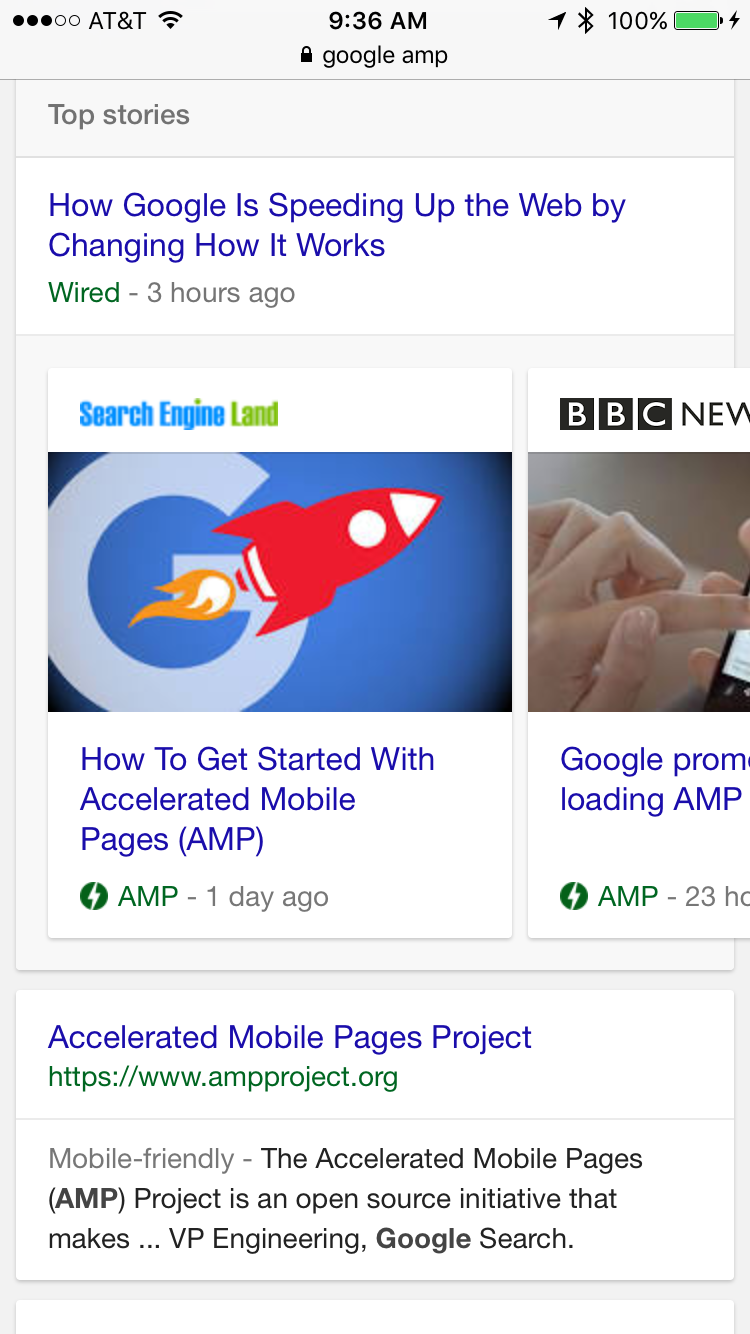AMP, or Accelerated Mobile Pages is one of Google’s recent initiatives to increase mobile performance for publishers content. Notice I say content, not website. Continue reading to see why we think that AMP isn’t yet something that should be on the majority of website owners’ radars.
Disclaimer: We’ve installed and configured AMP, which meant we got to know the AMP syntax very well. Actually, we even wrote a guide on how to use AMP and other mobile-only technologies earlier this year. This puts us in a good place to sum up our opinion below;
Accelerated Mobile Pages isn’t* yet** great for your mobile marketing strategy

Since hearing a number of expert opinions, as well as taking a step back and thinking through Google’s logic on introducing AMP, I’ve been able to reassess where I think AMP fits into a firms digital and mobile marketing strategy.
AMP isn’t a great move if you’re an SME, as you’re very unlikely to ever be featured in the AMP carousel, pictured right. Likewise, if you don’t regularly produce and promote content on your website, you’re unlikely to get listed.
In the UK, we still haven’t seen much happening with AMP article listings, and suspect that only those sites currently eligible to be included within Google News will be suitable for AMP inclusion for some time.
Implementing AMP support on your website isn’t actually too difficult, even if you have a bespoke content management system. There are many plugins for most popular content management systems now, including one for WordPress, our CMS of choice.
What’s annoying though, is two fold;
- Google is being prescriptive on what elements you’re allowed on your page, and
- Digital marketers are being coerced into allowing Google to scrape and serve up web pages in full, meaning we’re all slightly out of control.
Will Critchlow summed this up well on Twitter last year in speculating the potential next step for the search engine giant;
In fact, Will’s colleage Dom summarised this in a graph recently at UK SEO Conference BrightonSEO, where Impression was also represented on stage.

Limitations
Naturally, these platforms, especially where web hosting en masse is involved will come with limitations and security measures. Here are a few limitations of the markup language which have proved troublesome for sites out on the web;
- The feeling of lack of control. As Google is (optionally) hosting cached versions of your pages on its faster servers, you are ultimately not in control of what the user sees.
- Compared with not implementing the markup language syntax, AMP can be a lot of work. You’re not going to drop out of Google’s listings for not implementing this technology.
- Little-to-no benefit. Aside from some speed gains (which may well lead to more customers), many sites will not see any of the further benefits discussed on the AMP project website. Search engine results page carousels seem to be limited to the chosen few at the moment.
- The markup language itself is limiting. Even simple tasks, such as embedding a YouTube clip or Google Analytics tag requires its own syntax in the AMP markup language. Some scripts require the use of a sandboxed iframe as they’re not natively supported, for example like Wistia video hosting.
- Almost all non-Google and non-ad network JavaScript is disallowed. This means things like live chat and dynamic newsletter signups aren’t permitted and will not work.
* AMP is great for some publishers
Despite the general sentiment of this article, actually for some users, Accelerated Mobile Pages can be of great assistance. Generally this will be felt differently by two distinct groups; those with a great mobile UX, and those without.
** The mobile web will get better over time
As with all new technologies and initiatives, it’s likely that with further adoption and development, this technology will improve over time.
However, many firms still be stuck with the dilemma of to implement AMP, as given that in the time AMP tech will take to mature, many firms will have already been through a new mobile-first responsive web redesign.
AMP, and other technologies like it only exist to bridge the gap between desktop-only sites and growing mobile usage. Without this disconnect, these technologies are only a means to an end for large publishers to get an opportunity to further amplify their content on specific networks.
Getting gains without AMP
For those not already aware of the gigantic browsing habits shift towards mobile, this conversation has at least sparked some interest in what marketers should currently be looking towards for their mobile strategy.
Aside from the almost unobtainable snippet benefits from installing AMP, the main benefit is from vastly reduced load time. This has a very positive impact on user behaviour, as studies show that conversion rates are a lot higher when load time is quicker. If you or someone in your team is tech-savvy, then you should really look towards utilising server-side caching, extended browser caching and potentially also content delivery networks to speed up your website for your users.
We’ve optimised hundreds of websites for better SEO and UX. If you require our help in order to optimise yours, please get in touch here.





